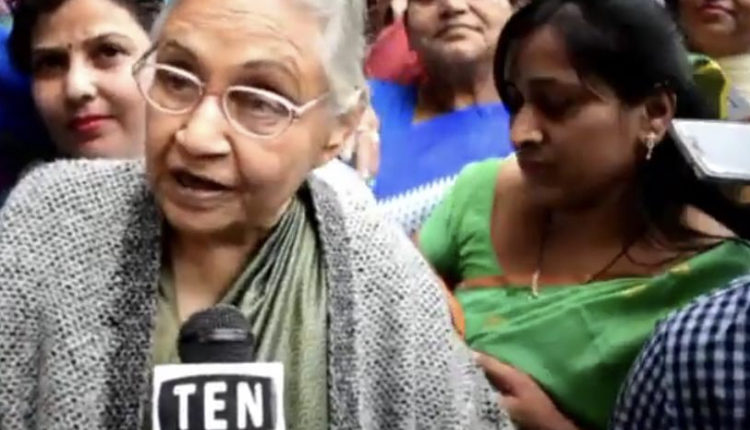Face of Delhi’s development – Sheila Dikshit
Sheila Dikshit, longest serving Indian women chief minister, leaves for heavenly abode
By
Pooran Chandra Pandey
Sheila Dikshit (31 March 1938 – 20 July 2019), an Indian politician and one of the longest-serving chief minister of Delhi as well as the longest-serving female chief minister of any Indian state serving for a period of 15 years (1998 to 2013), left for heavenly abode, at an age of 81, following cardiac arrest in New Delhi, yesterday around 4 pm.
Born on 31 March 1938 in Kapurthala, Punjab into a Punjabi Khatri family, she was educated at the Convent of Jesus and Mary School in New Delhi, graduating with a Masters degree in history from the Miranda House at the University of Delhi.
Dikshit was married to Vinod Dikshit, an IAS officer and a son of an independence activist and former West Bengal Governor Uma Shankar Dikshit, who came from Ugu village of Unnao in Uttar Pradesh.

Acceptable across the spectrum
Treated as a tall political figure who entered politics due to sheer chance of circumstances, she undertook several political and development challenges head on, leading those to their successful and logical conclusions. Seen as a consensus builder both in social and political circles, she got many of her development plans done through personal rapport and logical nature with political leadership at the centre.
In one instance, while meeting with Atal Bihari Vajpayee, former Indian prime minister, she is said to have convinced him to support her plan for Delhi’s development almost instantly, given her persona and art of persuasion, which even her political rivals agree and gave credence to. Such was her acceptance across the political spectrum, a reason largely seen as her success factor, got reflected even after death in stream of pourings of condolences from every political party, even after her death.
This, by any standard, is a rare phenomena that will long stay etched in all our memories.
Face of Delhi’s development
Delhi’s development over at last 15 years from 1998 since she became Delhi’s chief minister can well be traced back with fond memories. Be it Delhi Metro, 24X7 supply of electricity, bridges, traffic de-congestion, water issues, acess to health and education, women safety and successful organisation of Commonwealth Games (CWG) despite challenges are some of the high points and high lights of her tenure as Delhi’s chief minister. Additionally, given her firm belief of involving people in government’s decision making process for city’s development, further raised her image, profile and respect among people in Delhi and beyond, making the state as a benchmark for effective administration and attracting world attention to developing Delhi as a city which was at par with any other ‘smart’ city anywhere in the world.
In one of her private conversations ( later public), she wanted to see Delhi to develop on the lines of ‘Singapore’, a dream that began to bear fruits through execution of her urban centric development plans for Delhi.
My memories of her
In yet another instance of her concern for society and community, in 2009 during my stint with the Times of India, I had several opportunities of meeting and interacting her in a range of meetings and settings. Her affection, way she treated people, her humility and guidance on matters and issues was enough to attract people towards her once and for all. In one of meetings, I vividly recall, which was between a group of students who came from over 20 leading Indian academic institutions and universities to intern with the Times of India and to write a report on ‘State of Governance: Delhi Citizen Handbook’, she told the students as a parting note that they should work in the larger interest of society and community. The report was later prepared and launched in Delhi. Much as she wanted to come and launch the report, she could not due to her other pressing official engagements, she was however never to forget to send a hand written note – I am sorry not being able to make to today’s program much as I has wished for, my blessings are are with you all’. The note was handed over to me 5 minutes before the launch of the report began. Such was she and her persona which made one simply ponder over her caring nature, enduring charm and concern for her commitments.
Believer in ‘action’ and ‘approach’
She started her political career as a trainee and a political assistant to her father-in-law, supporting him in his routine correspondence and daily coordination of his office, learning elementary political lessons which later led to building her connections and network, eventually leading to a full blown political career. During her early career way back in 1970s, she became chairperson of the Young Women’s Association and was instrumental in the setting up two of the most successful hostels for working women in Delhi. She was also the secretary of the Indira Gandhi Memorial Trust, championing the cause of women empowerment and gender equality.
In her political journey that followed saw her catapulting to being the longest serving women chief minister of Delhi in India, Dikshit became a house hold name in Delhi in particular and in India and internationally, in general due to her sheer affable nature. Delhi being a political seat of the government, where she hosted several heads of states and foreign dignitaries during her tenure as Delhi’s chief minister, it was no surprise that several foreign embassies, high commissions and consulates also conveyed their personal condolences to her family upon her passing away, showing the personal rapport she had with many of these foreign missions and the mark of her sheer persona that she would have left behind in her personal interactions.
During her political career between 1984 and 1989, she represented Kannauj parliamentary constituency of Uttar Pradesh . As a member of Parliament, she also served on the Estimates Committee of Lok Sabha and also chaired the Implementation Committee for Commemoration of Forty Years of India’s Independence and Jawaharlal Nehru centenary. She also represented India at the United Nations Commission on Status of Women for five years (1984–1989). She also served as a Union Minister during 1986–1989, first as the minister of state for Parliamentary Affairs and later as a minister of state in the Prime Minister’s Office.
As a final chapter in her political career, she was sworn in as Governor of Kerala on 11 March 2014 and later declared as chief ministerial candidate for the Indian National Congress in the 2017 Uttar Pradesh Legislative Assembly elections. Subsequently, she was appointed as president of Delhi Pradesh Congress Committee on January 10, 2019.
Flexible yet tactical approach
Her overall approach was structured, logical and personal that came handy to her subsequent follow up and execution of plans and programs. A person who was the longest serving woman chief minister of India had all aces up her sleeves- both as a wise politician, a dotting mother to many and a loving sister to her political colleagues and rivals alike- unleashing a powerful combination of factors that was her sure way to win not only the points that she wanted to but also hearts of people due to her sheer humility, persona and witty nature.
A legacy beyond politics
She will long be remembered not for who she was as a person but more for what she has left behind for all of us- a beautiful Delhi and a looming figure of wit, approach and acumen to be emulated and followed through for by successive chief ministers regardless of their denomination and political affiliation. Dikshit is survived by her son Sandeep Dikshit, former member of parliament and her daughter Latika Syed, a social worker.
She will be missed and admired for a long time to come as she leaves behind a city legacy that will continue to reflect her charm in what she did for its development while, at the same time, keeping younger generation inspired to keep working on for their society and community- a message that is firmly etched into my personal memory during one of the longish interactions that I had with her in summer of 2019.
Note : Pooran Chandra Pandey is managing director of SOENT, an European policy consulting group besides having founded the first Anglo-Saxon think tank in Germany. He also sits on a number of boards of the UN, corporate houses, think tanks, media and not-for – profit organisations both in India and internationally. He has 12 books to his credit. He is also a British Chevening Scholar.




